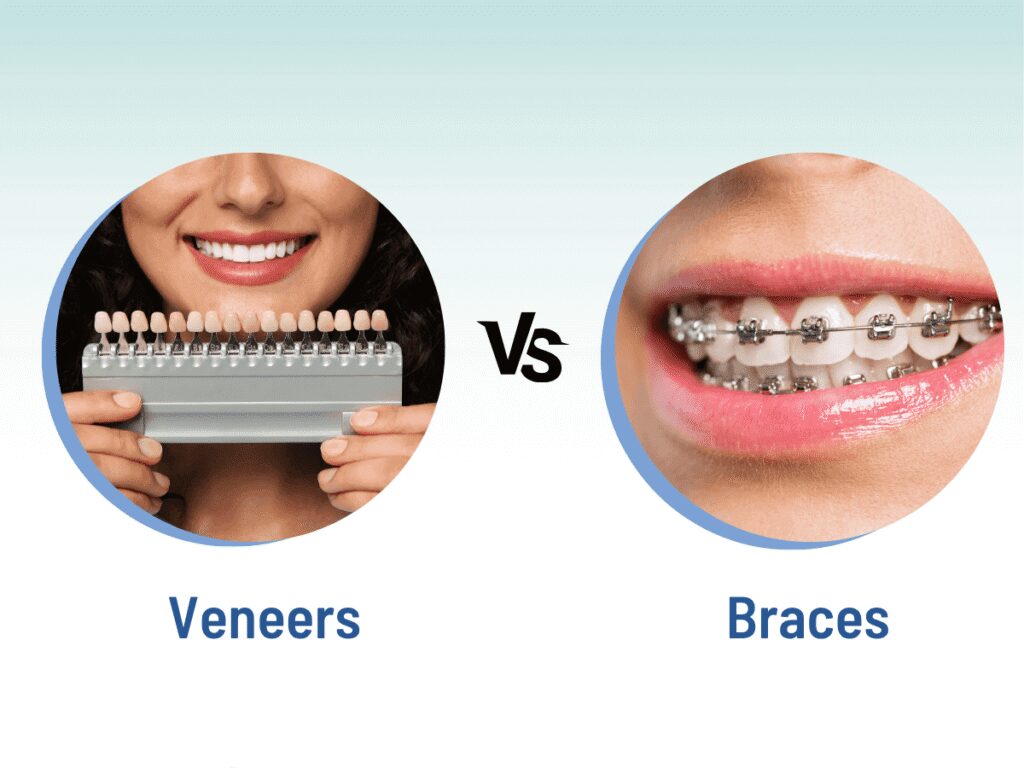Choosing between veneers and braces is a common decision for anyone looking to improve their smile. Both dental treatments can create noticeable results, but they work in very different ways. Veneers are thin, custom-made shells placed on the front of your teeth to enhance their shape and color, while braces gently move your teeth into proper alignment over time.
If you’re dealing with concerns like discoloration, small gaps, uneven teeth, or bite issues, understanding the differences between veneers and braces will help you make a confident and well-informed choice for your smile. In this article, you can get a detailed comparison of veneers vs braces and learn which treatment is better suited for your specific dental needs and for a beautiful smile.

| Aspect | Veneers | Braces |
| Purpose | Cosmetic enhancement of front teeth | Corrects bite and tooth alignment |
| Treatment Time | 2-3 weeks | 1-3 years |
| Cost Range | $800-2,000 per tooth | $3,000-7,000 total |
| Reversibility | Permanent (tooth structure removed) | Reversible |
| Maintenance | Replace every 10-15 years | Lifetime retainer wear |
| Best For | Minor cosmetic flaws, discoloration | Crooked teeth, bite issues, gaps |
| Age Suitability | Adults with mature teeth | Children, teens, adults |
What Are Dental Veneers?
Dental veneers are ultra-thin, custom-designed shells typically made from porcelain or composite resin materials. These cosmetic dental solutions are permanently bonded to the front surface of your teeth to improve their color, shape, size, and overall appearance.
Types of Veneers:
- Porcelain veneers: More durable, stain-resistant, and natural-looking
- Composite veneers: Less expensive, can be completed in one visit
How Veneers Work: The veneer procedure involves removing a thin layer of tooth enamel (typically 0.5mm) to accommodate the veneer thickness. Your dentist takes impressions, and custom veneers are crafted in a dental laboratory. Once ready, the veneers are bonded to your teeth using special dental cement.
Ideal Candidates for Veneers:
- Adults with healthy teeth and gums
- Patients with minor cosmetic concerns
- Those seeking a quick smile transformation
- People with sufficient tooth enamel
What Are Braces?
Braces are orthodontic appliances designed to gradually move teeth into proper alignment over time. They consist of brackets, wires, and bands that apply continuous pressure to shift teeth into their correct positions.
Types of Braces:
- Traditional metal braces: Most common and cost-effective
- Ceramic braces: Tooth-colored, less visible option
- Clear aligners: Removable, nearly invisible treatment
How Braces Work: Braces apply controlled pressure to teeth, causing them to move through the jawbone gradually. Regular adjustments every 4-6 weeks help guide teeth into their desired positions. The bone remodels around the new tooth positions, creating permanent changes.
Ideal Candidates for Braces:
- Patients with significant misalignment
- Children and teenagers with developing teeth
- Adults seeking comprehensive orthodontic correction
- Those with bite problems or jaw issues
Key Differences Between Veneers and Braces
Treatment Approach: Veneers provide cosmetic coverage to hide imperfections, while braces offer structural correction by physically moving teeth. This fundamental difference affects everything from treatment duration to long-term results.
Time Commitment: Veneers offer quick results within 2-3 weeks, making them ideal for patients wanting immediate smile transformation. Braces require 1-3 years of consistent wear, demanding long-term commitment and patience.
Invasiveness: Veneers require permanent tooth alteration through enamel removal, making the procedure irreversible. Braces provide non-invasive tooth movement without altering tooth structure.
Results: Veneers focus on appearance enhancement, while braces deliver functional improvements, including better bite alignment, easier cleaning, and improved oral health.
When to Choose Veneers
Consider veneers if you have:
- Minor cosmetic imperfections like small chips or cracks
- Stubborn tooth discoloration that doesn’t respond to teeth whitening treatments
- Small gaps between front teeth
- Desire for quick results before important events
- Healthy teeth with sufficient enamel
- Realistic expectations about maintenance requirements
Veneers work best for patients seeking dramatic cosmetic improvements without addressing underlying orthodontic issues.
When to Choose Braces for Teeth Alignment
Braces are recommended when you have:
- Significant tooth misalignment or crowding
- Bite problems (overbite, underbite, crossbite)
- Large gaps between teeth
- Jaw alignment issues
- Developing teeth (children and teenagers)
- Desire for comprehensive orthodontic correction
Orthodontic treatment with braces addresses the root causes of dental problems, providing long-lasting functional and aesthetic benefits.
Pros and Cons Analysis
Veneers Advantages:
- Quick results within weeks
- Dramatic smile transformation
- Stain-resistant porcelain material
- Minimal dietary restrictions
- Immediate confidence boost
Veneers Disadvantages:
- Permanent tooth alteration
- Higher cost per tooth
- Requires replacement every 10-15 years
- Limited to front teeth only
- Potential sensitivity issues
Braces Advantages:
- Addresses underlying dental problems
- Permanent correction results
- Insurance coverage is often available
- Improves overall oral health
- Suitable for all ages
Braces Disadvantages:
- Extended treatment time
- Dietary restrictions during treatment
- Visible appearance (traditional braces)
- Regular adjustment appointments
- Potential discomfort during adjustments
Cost Considerations and Investment Value
Initial Investment: Veneers typically cost $800-2,000 per tooth, making full smile makeovers expensive. Braces range from $3,000 to 10,000 for complete treatment, often covering all teeth.
Long-term Value: While braces require a higher upfront investment, they provide permanent results. Veneers need replacement every 10-15 years, increasing lifetime costs significantly.
Insurance Coverage: Most dental insurance plans cover orthodontic treatment (braces) partially, especially for children. Veneers are typically considered cosmetic and rarely covered by insurance.
Financing Options: Many dental practices offer payment plans, dental loans, or financing options to make both treatments more affordable. Some employers provide flexible spending accounts for dental expenses.
Bottom Line
The decision between veneers vs braces ultimately depends on your circumstances, dental health, and aesthetic goals. Veneers offer quick cosmetic enhancement for minor imperfections, while braces provide comprehensive orthodontic correction for significant alignment issues.
Consulting with qualified dental professionals is crucial for making the right choice. Schedule consultations with both cosmetic dentists and orthodontists to explore your options thoroughly. They can assess your specific needs, discuss treatment alternatives, and help you achieve the confident smile you deserve.
Remember, both treatments represent significant investments in your oral health and self-confidence. Take time to research, ask questions, and choose the option that best aligns with your long-term dental health goals and lifestyle preferences.
FAQ’s
1. Is it better to have braces or veneers?
It depends on your dental goals. Braces are better for correcting alignment problems, bite issues, and crowded teeth. Veneers are ideal for improving the appearance of teeth by changing their shape, size, and color. If you want functional correction, braces are the better choice. If you want a quick cosmetic improvement, veneers may be right for you.
2. How much is 1 tooth veneer?
The cost of one veneer typically ranges from $800 to $2,000 per tooth, depending on the material used and the dentist’s expertise. Porcelain veneers are more expensive but offer better durability and a more natural look.
3. Are veneers painful to get?
Most patients experience little to no pain during the veneer procedure. Your dentist uses local anesthesia while preparing the tooth, so you won’t feel discomfort. Some mild sensitivity may occur for a few days after treatment, but it usually fades quickly.
4. How long do veneers last compared to braces results?
Porcelain veneers usually last 10–15 years before they need replacement. Braces provide long-lasting results when you wear your retainers as instructed. Since braces address the root cause of misalignment, the benefits can last for life with proper maintenance.
5. Are braces or veneers better for gaps between teeth?
Small gaps can be closed with veneers for a quick cosmetic fix. Larger gaps or spacing caused by bite issues or jaw alignment are better treated with braces. The right option depends on the size and cause of the gap.
6. Which option is more permanent: veneers or braces?
Braces offer more permanent results because they physically move your teeth into new positions. Veneers are long-lasting but need replacement over time, and the tooth enamel removed during the procedure cannot be restored. If long-term correction is your priority, braces have the advantage.



